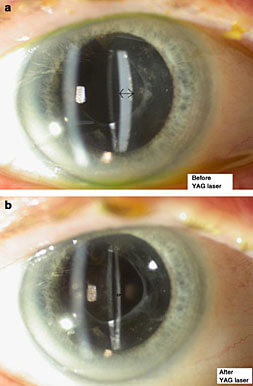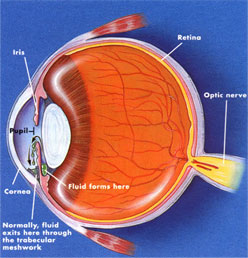
Femtosecond Laser

The latest technology in the world of eye surgery is “laser guided laser cataract surgery.” Although we use many different lasers to treat various eye conditions and diseases, lasers have not been used in laser cataract surgery until recently. These sophisticated femtosecond lasers represent a revolutionary advance that is now being adopted by leading eye centers throughout the United States.
YAG Laser Capsulotomy

The YAG laser is used to open the posterior lens capsule (posterior capsulotomy). This capsule is the thin protective membrane left in the eye following laser cataract surgery. If it becomes cloudy (posterior capsular haze), as it does in about one patient out of five, this membrane can be opened safely by the YAG laser.
Usually, increased glare from bright lights or a gradual decrease in vision are the first signs of posterior capsular haze. Further testing will easily confirm the diagnosis.
The posterior capsulotomy is a simple, quick procedure. A laser beam is used to create an opening in the center of the cloudy capsule. There is no pain or chance of infection since no incision is required. The risk of complication is less than one percent.
There are no restrictions on activities. The majority of patients enjoy improved vision almost immediately. The rest experience gradual improvement over a period of several days.
Selective Laser Trabeculoplasty (SLT)

Selective Laser Trabeculoplasty (SLT) represents an advancement in laser technology that allows ophthalmologists to safely and effectively treat open-angle glaucoma.
SLT involves applying laser light to a specific part of the eye that is involved in removing fluid from the eye. Using a special wavelength and energy setting, the laser affects only pigmented (melanin containing) cells of your eye. SLT improves the flow of fluid from the eye, which in turn lowers your eye pressure.
How SLT is performed
SLT is performed in the physician’s office and only takes a few minutes. Prior to the procedure, eye drops will be given to prepare the eye for treatment. The laser applications are made through a special microscope, similar to the one used for eye examinations.
What to be expected after SLT treatment
Your eye pressure may drop as quickly as a day or two after having SLT performed. The doctor may treat the eye with anti-inflammatory eye drops that will be continued after the procedure. You will be instructed to continue with your glaucoma drops and other medications until the doctor has advised you if any drops should be discontinued. The full effectiveness of the SLT is usually seen at about six weeks after the procedure is done.
Endolaser
Lighting The Way For Glaucoma Sufferers
How Does The Endolaser Treat Glaucoma?
The Endocyclophotocoagulation procedure or ECP uses a gentle form of light energy to decrease the fluid production and pressure in the eye. The ECP is performed at the time of laser cataract surgery and the surgeon uses the same incisions for both procedures.
How Is The Endolaser Used?
First, the surgeon makes a small self-sealing incision through the cornea of the eye (the clear window on the eye’s surface). The eye’s fluid is replaced with a jelly-like material that stabilizes and protects the delicate eye tissues. Next, the surgeon inserts a tiny fiberoptic probe, about the diameter of the wire in a paper clip, into the eye. This probe is connected to a sophisticated video camera that allows the surgeon to see in a highly magnified manner the delicate microscopic structures inside the eye. Under direct observation, the surgeon applies gentle laser light energy to the ciliary processes, structures found behind the iris of the eye and responsible for the eye’s fluid production. This light therapy is applied to individual ciliary processes. The entire procedure is completely painless and can be performed in minutes. Once the therapy is completed the fiberoptic probe is removed from the eye, the clear jelly-like material is evacuated from the eye and the procedure is completed. The incision is so small that it seals automatically and requires no stitches.
What Can I Expect From The Endolaser Procedure?
The Endolaser procedure is both safe and painless. In over fifteen years of routine use of the Endolaser at our center we know that it offers an exciting highly effective and proven method for controlling glaucoma.
On the basis of our extensive experience with the Endolaser we know that most patients undergoing Endolaser experience a marked decrease in their eye pressure and are sometimes able to dramatically reduce the number of glaucoma medications they take. In fact, we have found that twice as many patients demonstrate a pressure in the desired target range after the laser surgery compared to before surgery.
In many cases, we have been able reduce or eliminate the need for glaucoma medications. This is especially helpful in those patients experiencing side effects such as upset stomach, appetite loss, decreased night vision or eye irritation. Remarkably, due to the effectiveness of this procedure, one in four patients are able to stop all their glaucoma medications entirely.
If you would like to book your appointment online click here or call (561) 338-7722 today!
